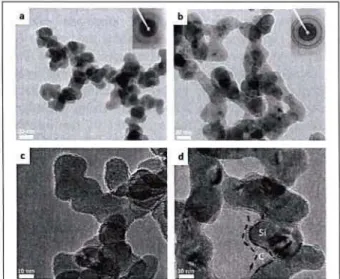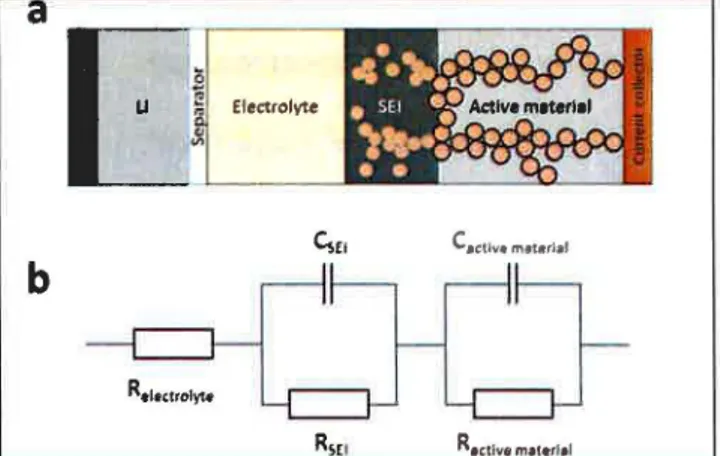HAL Id: cea-02341516
https://hal-cea.archives-ouvertes.fr/cea-02341516
Submitted on 31 Oct 2019
HAL is a multi-disciplinary open access
archive for the deposit and dissemination of
sci-entific research documents, whether they are
pub-lished or not. The documents may come from
teaching and research institutions in France or
abroad, or from public or private research centers.
L’archive ouverte pluridisciplinaire HAL, est
destinée au dépôt et à la diffusion de documents
scientifiques de niveau recherche, publiés ou non,
émanant des établissements d’enseignement et de
recherche français ou étrangers, des laboratoires
publics ou privés.
Silicon core - carbon shell nanoparticles for Li-ion
batteries anodes. Relationship between morphology and
degradation mechanism studied by Impedance
spectroscopy
Antoine Desrues, John Alper, Florent Boismain, Eddy Foy, Sylvain Franger,
Cédric Haon, Nathalie Herlin-Boime
To cite this version:
Antoine Desrues, John Alper, Florent Boismain, Eddy Foy, Sylvain Franger, et al.. Silicon core - carbon
shell nanoparticles for Li-ion batteries anodes. Relationship between morphology and degradation
mechanism studied by Impedance spectroscopy. LiBD-8 ”Electrode Materials”, Jun 2017, Arcachon,
France. �cea-02341516�
LiBD-8 2017 - "Electrode materials" Arcachon, France June 11-16,2017
Silicon core - carbon shell nanoparticles for Li-ion batteries anodes. Relationship between
morphology and degradation mechanism studied by Impedance spectroscopy
Antoine Desruesl, John P. Alper1.2, Florent Boismainl, Eddy Foyl, Sylvain Franger3
, Cédric Haon2,
Nathalie Herlin-Boimel
1 NIMBE, CEA, CNRS, Université Paris-Saclay, CEA Saclay, 91191 Gif-sur-Yvette, France 2 CEA, LITEN, 17 rue des Martyrs, 38054 Grenoble, France
3 ICMMO (UMR CNRS 8182), Université Paris SudlUniversité Paris-Saclay, 15 Avenue Georges Clémenceau, 91405
Orsay Cedex, France
Performant electrochemical storage devices appear as one of the solution to face the challenge of energy transition and development of carbon-less energy processes. In this context, lithium-ion batteries are a well-developed technology because of their lllgh energy density, their long life over cycling and their large field of applications, from microbatteries to stationary storage 1.
This work is focused on increasing the negative electrode's capacity by understanding the degradation mechanism occurring in the material. Graphitic carbon is commonly used as a negative electrode in commercial battery systems because of its stability, electronic conductivity, and its natural abundance. However, its maximum energy density remains too low to meet the requirements of demanding applications such as electric vehicles. Silicon is a promising alternative anode material to increase the capacity of the anode up to 3579 mAh/g, ten times higher than the 350 mAh/g of graphité. In silicon materials, lithiation and delithiation processes induce a 300 % volume change linked to the cleavage of the Si-Si bonds and the formation of a LilsS4 allol. This dramatic structure change induces high mechanical stress 4 which results in material fracture and rapid fading of performance.
Replacing bulk silicon material by nanometric particles is a well-known solution to alleviate this fracture problems. An issue that becomes predominant at this scale size is the formation of an interphase between the electrolyte and the solid, and commonly named SEI. This SEI stability is fundamental to obtain stable performance of silicon electrodes.
Due to its ionic and electronic conductivity properties, the coating of the silicon surface by carbon has proved to protect the bare silicon surface and obtain a more stable SEI 6.
In this work we synthesize core-shell carbon coated silicon nanoparticles (here designated Si@C) through double-stage laser pyrolysis. In the fIfst reaction zone the laser induces decomposition of flowing silane in He to yield the silicon core. Amorphous (a-Si) and crystalline (c-Si) silicon core particles have been obtained (Figure la and lb) and the crystallinity determined by nanodiffraction (inset of la and lb). By adding a second stage where a carbon precursor (ethylene) is introduced into the flow of particles and subsequently decomposed by a second pass of the laser
carbon coated Si@C is formed. Carbon-coated amorphous (a-Si@C) and crystalline (c-Si@C) core-shell particles have been obtained (Figure lc and Id). and used as anode materials in the same coin cell configuration as the uncoated materials7•
Figure 1 : Representative TEM images of amorphous (a) and crystalline (b) materials a-Si@C (c) and c-Si@C (d)
As shown in Figure 1, this synthesis results in particles of a "chain-like" morphology. Figure 1 d shows evidences of a carbon shell presence, in good agreement with the results of chemical analysis, with a 6.7% for c-Si@C and 10% for a-c-Si@C. The comparison of electrochemical performances for coated and uncoated materials has been performed. The protective effect of the shell is demonstrated by a much higher specific capacity remains 300 cycles at C/5 for the coated materiaC. However, a large loss of capacity occurs during the fIfSt few cycles drastically reducing the lifetime performance of these electrochemical cells.
A powerful technique to probe such phenomena is Electrochemical Impedance spectroscopy (EIS).
LiBD-8 2017 - "Electrode materials" Arcachon, France June 11-16, 2017
a
b
Figure 2 : a simplified scheme of the electrochemical cell (a) and the model circuit used for fitting (b)
,,
'
Two mechanisms are suspected to reduce the capacity of the Si materials. First the volume change during cycling causes SEI expansion and cracking which exposes the underlying electrode material surface. This exposed surface enables continuous SEI creation with consumption of lithium followed by a rapid capacity fade. It is important to understand the SEI behavior in these frrst cycles and compare different materials. This can be achieved by using impedance spectroscopy to probe the evolution of the interface between different components of the electrochemical cells. The interfaces are shown in the simplified scheme of Figure 2.b. The SEI is at the interface between the active material and the electrolyte and EIS measures its electrical resistance. The behavior of the carbon shell can be extracted from the impedance comparison of a coated and an uncoated material.
High resolution EIS has been performed, meaning 50 EIS measurements were carried out during one lithiation or delithiation. This is used to investigate the changes during the SEI growth correlated to these structural modifications in the active material and in the carbon shell. An electrode of tested materials is assembled in a two electrode coin cell. In each battery, the frrst and the second cycles are compared. Then, the experiment is interrupted at the fiftieth cycles and the same number of EIS spectra are acquired in order to examine the ageing of the electrode. In a second experiment, three ele,ctrodes measurement have been acquired to remove the lithium contribution to the measured impedance.
a
b l , ,
a-SI
..
Fi ure 3 : Active material and SEI resistance in function of
the voltage for crystalline (a) and amorphous (b) materials.
The spectra obtained are then fitted to obtain the resistance values in the battery systems. The equivalent circuit used for modelling is shown in Figure 2.b. Figure 3 shows the resistances of active matter and SEI for amorphous and crystalline materials. Resistance values can be extracted and correlated to the degradation mechanisms. Amorphous materials have a better electrochemical behavior than crystalline materials. The results also confrrm the protective effect of the carbon shell because the resistance increases less in the case of the Si@C materials compared to the Si materials.
Looki~g forward, we will perform EIS characterization of a wider range of materials to see the effect of the carbon shell thickness and silicon core size on the impedance properties in order to optimize synthesis conditions and resulting anode material.
References
Armand, M. & Tarascon, J.-M. Building better batteries. Nature 451, 652-657 (2008).
2 Obrovac, M. & Chevrier, V. Alloy negative electrodes for Li-ion batteries. Chemical reviews 114,11444-11502 (2014).
3 McDowell, M. T. et al. In situ TEM of
two-phase lithiation of amorphous silicon nanospheres. Nana letters 13, 758-764 (2013).
4 Liu, X. H. et al. Anisotropic swelling and
fracture of silicon nanowires during lithiation.
Nana letters 11, 3312-3318 (2011).
5 Liu, X. H. et al. Size-Dependent Fracture of
Silicon Nanoparticles During Lithiation. Acs Nana 6, 1522-1531, doi:1O.10211nn204476h
(2012).
6 Terranova, M. L., Orlanducci, S., Tamburri, E., Guglielmotti, V. & Rossi, M. SilC hybrid nanostructures for Li-ion anodes: An overview.
Journal of Power Sources 246, 167-177
(2014).
7 Sourice, J. et al. One-step synthesis of Si@ C
nanoparticles by laser pyrolysis: High-capacity anode material for lithium-ion batteries. ACS
applied materials & interfaces 7, 6637-6644

